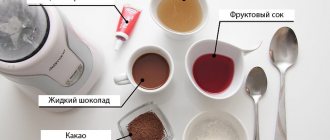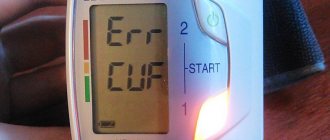Read in this article:
- Types of malfunctions of tonometers
- Mechanical damage and display problems
- Impaired cuff filling
- Error symbols on the device screen
- Cuff selection
- Replacing batteries and caring for the tonometer
- Violation of pressure measurement rules
- What to do if you have problems with the operation of the tonometer
An automatic tonometer is a simple and convenient device for determining blood pressure. With such a device, you do not need to listen to barely audible sounds through a phonendoscope, try to look at the numbers on the pressure gauge, and even inflate the cuff. The device itself performs all these functions and displays the measurement results on the display.
Types of devices
- Types of devices
- How to repair a tonometer correctly: features and recommendations? How to repair a mechanical tonometer with your own hands?
- Features of electronic equipment repair
The devices under consideration are divided into three types.
Each has certain modifications and also differs from others in its operating principle. All types have positive and negative sides. Mechanical offers high precision and low cost. But it takes skill to learn how to use it yourself. A semi-automatic one is much easier to work with and breaks down less often. An electronic tonometer is more expensive and has a higher error. Even a child can measure blood pressure with it. Just put on the cuff and press the button, after a while the result will be displayed on the display. Mechanical device
As a rule, device repair consists of changing the component unit. Why do you need to buy a new mechanism and replace the broken one with it? For example, it is impossible to inflate the cuff with air. This means that the pumping check valve in the bulb has broken. It is pointless to change only the valve; you need to replace the entire assembly, along with the tubes.
Electronic and semi-automatic machines are several times more expensive than a mechanical device. These types of devices do not have very frequent malfunctions. What often happens:
- malfunctions in the mechanism itself;
- absence or delay in displaying indicators;
Problems in displaying indicators - violations of the cuff filling with air;
- formation of incorrect indicators in comparison with other types of devices.
Semi-automatic device
It is better to fix serious breakdowns at a service center, because a warranty card is issued for repairs, and until it expires, it is prohibited to carry out repairs on your own. You can change the bulb, cuff, and batteries yourself; the warranty card does not apply to them.
The device is automatic
Heart rate
The third digit located on the device display is the pulse. This figure is located in the bottom row under the pressure indicators.
Heart rate indicator
It is not difficult to understand what this or that number located on various models of tonometers for measuring pressure means. Heart rate depends on the age and gender of a person; on average, this indicator varies from 60 to 90 beats in 60 seconds. A rarer pulse may indicate bradycardia, a more frequent pulse may indicate tachycardia.
How to repair a tonometer correctly: features and recommendations?
If you decide to save time and money and repair the tonometer yourself, you must first find faults in the device. If a person uses it often, then identifying a broken part will not be difficult. If the problem is air leaking from the system, then it needs to be identified. Having found the place where the air is leaking, you simply need to replace this element with a new one. If after this the pressure measurement went well, then everything worked out.
How to repair a mechanical tonometer with your own hands?
What kind of breakdowns can a mechanical device have and how to fix them yourself:
- The cause of the breakdown is the pressure gauge needle falling out.
There is no way to fix the problem yourself. It is recommended to buy a new pressure gauge and replace the broken one with it. Pressure gauge in a mechanical tonometer - Air is leaking in the device - you need to find the location of the leak. This could be in the hose connections, in the bulb, or in the cuff. The faulty element must be replaced.
- In the supercharger, the air bleed valve, which is located on the back of the faucet, sticks - they bleed air during the process.
It is necessary to replace the bulb - if the tube is leaking air, then cut out the holey section and attach the pipe to the bulb. Sticking valve in bulb - The faucet quickly poisons the air - replace either just it or the entire blower.
You can buy the necessary part for a mechanical tonometer in an online store, order by phone, or in a medical equipment store.
Features of electronic equipment repair
Breakdowns and repair methods for electronic devices:
- When unrealistic indicators are displayed on the display, you must first replace the battery.
If this does not help, you need to look for an air leak in the cuff, bulb and the pipe connecting them. Here, repairs are carried out depending on the circumstances: replacement with new parts or elimination of leaks. A quick solution to the problem is to change the battery - If you tried to fix the breakdown, everything that could be replaced, but air is leaking, then you need to take the device to a service center or even buy a new tonometer. The device itself is considered a durable device, but the camera and bulb in it are designed for 2-3 years of use.
- Most often, the cause of malfunction of a semi-automatic tonometer lies in the blower, which supplies air to the cuff, or in the cuff itself. They just need to be replaced with new ones. But the faucet for bleeding air works for a long time without breakdowns.
Automatic devices are not so easy to disable. If the tonometer is not dropped, hit or shaken forcefully, it will last for many years. The electronics inside the camera are quite fragile and require delicate and careful handling.
Arrhythmia indicator
The arrhythmia indicator is an icon located on the device display. As a rule, it is located at the very bottom of the screen, closer to the center. Depending on the make and model of the device, the appearance of the icon can vary significantly, but most often this symbol looks like a flashing heart.
The icon lights up if the heart rhythm is uneven. This may indicate both the arrhythmia of the human heart and interference that arose during the measurement.
In order to exclude a random factor, you need to repeat the procedure after a few minutes. If, during three repetitions performed while the patient is at rest, an arrhythmia icon appears on the display, the user should report this fact to the therapist or cardiologist as soon as possible.
Repairing a holey cuff
If the problem is bleeding air, then you need to find the location of the gap. When it is located directly on the cuff, it does not have to be replaced; it can be repaired. How to repair a leaky blood pressure cuff:
- If the hole is small and the cuff is strong and unworn, then you can seal it with a hot glue gun.
- You can glue a piece of rubber patch or other suitable material onto the gap with rubber cement.
- Take a strip of thick aluminum and bend it in half. Push the damaged area between them and clamp it with metal, help yourself with pliers. Cover this place with glue.
Replaceable cuff
When air escapes at the factory soldering site, it can be vulcanized with a soldering iron at 180 degrees. It is important to remember that repairing a cuff is cheaper than replacing it, but it will not last too long after the intervention. Therefore, be prepared to replace this element.
Motion indicator
On some tonometer models there is a motion indicator on the display. As a rule, it depicts a human figure.
Movements while using the device can cause the device to display incorrect data, which in turn will lead to an error in diagnosis. The appearance of a motion icon on the device screen encourages the user to assume a state of rest and take the measurement again.
Choosing a blood pressure measuring device
Timely diagnosis of hypertension helps to begin treatment and prevent possible complications of this condition. To monitor your blood pressure (BP) and notice “problems”, you will need to buy a device that allows you to quickly measure it at home. If your blood pressure is high, you should take medicine or call a doctor for medical assistance. Therefore, if there is a person suffering from hypertension in the family, there must be a device for measuring blood pressure in the house.
Purpose of devices and their classification
The device for measuring pressure is called a tonometer. There is a wide range of such devices, which differ from each other in purpose, principle of operation, price and size. All of them have a clear interface and are therefore easy to use. Before using the device for the first time, you must read its instructions. You don’t need to be a doctor, since anyone can take measurements.
Which pressure measuring device is better and what should you pay attention to when choosing? Before buying a tonometer, you need to familiarize yourself with the commercially available models, compare their functions, and only then purchase an acceptable device.
The main parameter of a tonometer is accuracy, so it is recommended to choose a device not by price, but by this characteristic. Buyers are offered the following types of tonometers:
- mechanical;
- automatic (or semi-automatic);
- on the wrist.
Self-measurement of blood pressure gives more reliable results than in a hospital, since the patient is calm and has no fear of the white coat. But before choosing a tonometer, we suggest that you familiarize yourself with their technical characteristics.
Mechanical
This is a more affordable and at the same time accurate device that can be used to measure pressure. Its main disadvantage is considered to be inconvenience of use, however, as you gain experience, the procedure will proceed without any hitches. In addition, it is difficult to take measurements yourself with a mechanical apparatus, but if you have an assistant, this disadvantage completely disappears.
To measure blood pressure using a mechanical device, it is important to have good hearing and vision. Pros of this tonometer:
- acceptable price;
- long service life;
- accuracy;
- wear resistance.
To be completely confident in the normal operation of your device, it is important to regularly have it checked by a company specializing in this matter. Professionals will be able to adjust the tonometer, check its performance, and, if necessary, repair it.
When buying a mechanical tonometer, you should give preference to official products from popular companies rather than opting for cheap Chinese devices that are short-lived and inaccurate. After all, errors in obtaining blood pressure results often provoke a hypertensive crisis and cause health problems in a person.
Automatic and semi-automatic machines
Using an automatic tonometer, blood pressure and pulse are measured, and heartbeat disorders caused by arrhythmia are diagnosed. The operating principle of this device is that, using an electric pump, air enters the tire worn on the hand, then a special unit processes the obtained indicators, and the final results are reflected on the display.
Advantages of the model:
- compact size;
- ease of use;
- the ability to detect arrhythmia;
- pulse counting.
Automatic blood pressure monitors operate on mains power or batteries. Devices of the first type are convenient to use, since they allow you to determine blood pressure in any place, regardless of the presence of electricity.
But, not paying attention to the positive qualities, experts do not recommend purchasing automatic tonometers. After all, the electronic unit is not considered sensitive in comparison with the human ear, so such devices often show incorrect results. Automatic devices are most often chosen by patients with vision or hearing problems, and those who do not have such health problems are recommended to use semi-automatic devices.
The disadvantages of automatic devices are also their high cost and fragility.
Semi-automatic models are the most popular device used at home. It consists of a bulb, a cuff and an electronic unit that reads and interprets information, and then displays it on the screen. Such a device also operates from batteries or from the mains.
Advantages of semi-automatic machines:
- belong to the middle price category;
- allow you to measure pressure yourself;
- reliable and durable;
- make it possible to determine the pulse, as well as detect the presence of arrhythmia;
- show the correct result.
Semi-automatic blood pressure monitors are considered an ideal option for self-measurement of blood pressure. These are compact, accurate and convenient devices, which, like any other, are endowed with disadvantages. They are expensive in relation to mechanical devices, and if malfunctions occur, you will need to spend money on repairs. Also, sometimes you should turn on the tonometer to recharge or change the batteries.
Wrist-worn devices
Another subspecies is an electronic device for measuring pressure on the wrist. They are practically no different from others, except for their scope of application. Most often, these tonometers are used by people involved in sports. Quite convenient and small, the devices allow you to monitor blood pressure during training.
You should not use a wrist-mounted tonometer if the patient has heart problems or is diagnosed with hypertension, since the readings will not be accurate.
Advantages of the devices:
- mobility;
- many functions;
- built-in modes that allow you to monitor blood pressure even when a person moves.
The disadvantage of wrist tonometers is the inaccuracy of measurement, since they often have a large error.
Additional features
As mentioned above, mechanical equipment is not endowed with additional functions, while other types of tonometers are capable of not only measuring blood pressure.
Additional features that automatic, semi-automatic and wrist blood pressure monitors can support:
Automatic shutdown.
To prevent the tonometer from running idle if you forgot to turn it off, the automatic shutdown function will work after some time of inactivity.
Memory.
Some devices have automatic detection of time and date. Such devices record exactly when a person measured his blood pressure, making it possible to create a schedule that allows him to monitor his health status. This method helps to check how effective medications used to normalize blood pressure are.
Average indicators.
In order to obtain an accurate test result, automatic devices independently measure blood pressure several times in a row, and then display the average values on the screen. Thanks to these properties of the device, it is possible to reduce the error of the results.
Heart dysfunction.
Using this function, arrhythmia can be detected in time.
Availability of audio.
There are models that are designed for blind people, and the results obtained are voiced.
Pulse measurement.
This feature is useful for those who play sports or struggle with excess weight. To achieve good results, you need to regularly monitor the frequency with which the blood pulsates in the arteries.
As evidenced by patient reviews, such functions are not always required, so you need to choose a device only according to your needs.
Review of manufacturers
Device setup
You can check the tonometer for accuracy at a pharmacy. This check is carried out using a reference device. If any faults are detected at the time of purchase, you can return the device and replace it with a working one. There is also a special monitoring installation that is used to check the accuracy of the device. But it is expensive, so not everyone can afford to buy it for home setup of the device. You can also contact a workshop where it is possible to check the tonometer for accuracy and carry out repairs if necessary.
You can also connect two devices to the cuff at the same time. If one of these devices is adjusted accurately, then such a check of the tonometer is possible at home.
What goes wrong most often?
The most common malfunction requiring repair in blood pressure measuring devices is loss of cuff tightness. In mechanical models, when air is pumped into the cuff, it will not linger. In electronic devices, an error message will appear on the display. The device can be repaired by replacing the cuff. On a mechanical device, such repairs are easy to do yourself. And with an electronic device you will have to contact the service, since some models require reprogramming. Some devices have rubber cuffs, so sealant can help. It should be applied to the air bleed area, and the device will last a little longer.
An equally popular problem is the error in measuring blood pressure. For some reason, the device stops showing real numbers. Most often, electronic devices suffer this fate. It is likely that the problem is in the sensor that reads the pulses and calculates the tone of the arteries, or in the compressor of the device. Repair only at the service center.
Another breakdown of the devices is the malfunction of the electronics. There can be many reasons and all of them need to be looked for in the tonometer board.
Partial loss of segments of numbers also becomes a problem. If replacing the battery does not help, then the reason should be looked for in the firmware of the meters. Such repairs can only be performed by a specialist.
Electronic devices often suffer from button failure. Again, in the instructions, the manufacturer indicates the approximate number of presses before failure. This is simply mechanical wear of parts.
Error correction
Errors may occur when using the tonometer. Some of them you can fix yourself. If this does not work for some reason, disassembling the device yourself is highly not recommended.
Firstly, without knowledge of the features of this device, you can only aggravate the situation. Secondly, after opening the tonometer and damaging the factory seals, the free warranty period of service is automatically canceled.
The table shows the most common errors and methods for eliminating them.
| Type of error | Causes | Correction Methods |
| Flashing heart sign | Heart rate too high | Remove the device from your wrist, wait 10-15 minutes, and then measure your blood pressure again. If the situation repeats, then most likely the indicators are correct. In this case, you need to consult a doctor. |
| E E Snowflake symbol | The cuff is full of air | You need to remove the device from your hand, turn it off, and then turn it on. Next, you should measure your blood pressure again. |
| E 78 Snowflake symbol | The cuff is not securely fastened or there was movement of the arm during measurement | Turn off the device, turn it on, measure blood pressure again. |
| Er 25 | The symbol “E” with any code indicates some kind of malfunction in the device. | You need to contact the service center. |
| Indicators are too low or, conversely, excessively increased | This error can occur for several reasons: |
1. The cuff is not fastened correctly.
2. The hand with the device is not at heart level.
3. There were movements or conversations during measurements.
4. The arm is overextended.
Note.
Blood pressure readings may change throughout the day. As a rule, this is not related to the operation of the device. Changes in blood pressure depend on the time of day, weather conditions, as well as the physical and moral state of a person.
How to correctly measure blood pressure with an electronic tonometer on the wrist
A tonometer is a medical device used to obtain information about the state of a person’s blood pressure. Its main advantage is the accuracy of the results. Tonometers are used in medical institutions. Due to its affordable price and ease of use, it is also used at home. Allows for timely detection of hypertension and initiation of its treatment.
The first attempts to measure blood pressure were a long time ago. The final version of the tonometer was created at the beginning of the last century. Then the Russian military surgeon Nikolai Korotkov proposed to simplify the tonometer that existed at that time, readings from which were taken using columns filled with mercury.
Korotkov replaced mercury columns with a stethoscope and took readings by listening to the pulse. For more than half a century, the Korotkov tonometer remained the only device for measuring blood pressure, and only in 1965 the American doctor Seymour London proposed improving it by replacing the rubber bulb with a compressor and the stethoscope with a microphone.
Who should use a wrist pressure measuring device?
If you lead an active lifestyle, doctors definitely recommend choosing a device for measuring pressure on your wrist. It is accurate, easy to use, and compact, which allows you to easily carry it in your purse or take it on trips. A device for measuring human pressure on the wrist is also used in children and adolescents.
For older people, an automatic tonometer on the forearm is more suitable. As blood vessels wear out with age, measuring pressure at the wrist may not be as accurate. All kinds of microtraumas to the wrist can also interfere with obtaining the correct result from such a tonometer. Joint diseases also reduce the chance of getting the correct measurement result.
However, the latest generation of wrist blood pressure monitors is equipped with the function of reading the pulse from two arteries, which allows its use in older people with poor blood vessels. Which is very convenient for older patients who are overweight and lead a sedentary lifestyle.
Externally, such a device looks like a large clock. It is extremely easy to put on - thanks to a special cuff, the pressure gauge, equipped with all the necessary components, is attached to the wrist. Its use does not require any skills.
How to correctly measure blood pressure with a tonometer on your wrist
To get accurate pressure measurements, you need to do this correctly.
- You need to measure your blood pressure no earlier than an hour and a half after eating;
- If you are a smoker, then you need to give up cigarettes at least an hour before the measurements; during smoking, the blood vessels narrow, which contributes to an increase in blood pressure;
- Tea and coffee can also affect the result, so we exclude them;
- Half an hour before the measurements, you should give up any physical activity, allow the body to calm down from the emotional shock and return to a normal working rhythm. Otherwise, you can get inflated results and take this indicator as a manifestation of hypertension;
- Five minutes before the measurements, completely calm down, just sit quietly on a chair during this time;
- The wrist cuff should not be too tight or loose;
- During measurements, you cannot talk, move your hands, much less walk;
- A person should sit, the angle of bend of the knees should not be less than 90 degrees. In no case do we cross them;
- You should not strain your back; it is better to lean on the back of a chair or armchair and relax. Incorrect posture leads to kinking of the arteries and a natural increase in pressure;
- Before measuring blood pressure, you need to take off your watch, free your wrist from clothes, even a thin sleeve can interfere;
- During measurements, you need to keep your hand at heart level, supporting your hand with the other. Remember, if you move your hand five centimeters higher or lower, the measurements become inaccurate. When the hand is lowered, the readings will be overestimated; when raised too high, the readings will be underestimated.
How to choose the right blood pressure monitor for your wrist?
- First of all, we need to be very clear about whose blood pressure we will measure using this device. For a child, you need to purchase a tonometer with a small cuff with a small diameter. The cuff should fit snugly on your arm and not dangle. There are blood pressure monitors for pregnant women, the elderly and athletes. They all differ in the range of functions they offer.
- When choosing a wrist blood pressure monitor, we proceed from the functionality that we would like to have available. If the device will be used by several people, it would be nice to have several memory cells. The function of detecting arrhythmia during the measurement process will not be superfluous. Automatic heart rate calculation will help you get a more complete and adequate picture of the state of the body.
- When purchasing a tonometer, it is a good idea to find out the warranty period that the manufacturer gives for its product. If the warranty lasts only a year or two, it is better to refuse such a purchase; most likely, this is not a very reliable device that may soon fail. A high-quality tonometer has a warranty period of at least five years, and sometimes longer. Remember, a tonometer is bought for many years.
- If you have a very wide wrist, you should pay special attention to such an item as the size of the cuff. Don't hesitate to ask the seller to let you try on a blood pressure monitor to make sure this model is right for you.
- Pay attention to the errors that this tonometer model gives. The smaller it is, the more accurate the result you will get. An error of 3-5 mm is quite acceptable.
- When purchasing a tonometer, its cost plays an important role. The price should adequately reflect the available functionality. If the blood pressure monitor is too expensive, consider whether you really need all the features it offers.
Among modern models of wrist tonometers, the most popular are devices from Japanese manufacturers OMRON and AND. Models from these companies are easy to use and durable. For a very reasonable price, you can get all the necessary functionality without overpaying for unnecessary options. Their average cost varies between 2000-3000 rubles.
They have a large, convenient display with large numbers, which will be especially appreciated by patients with poor vision. These tonometers also have pulse counting. Some blood pressure monitors store up to 90 recent measurements in memory. The cuff width of these tonometers varies from 13 to 21 cm, so choosing the right one will not be difficult.
Models that cost up to seven thousand rubles can have a memory of up to 180 measurements. Their cuff width also reaches 21 cm. Unlike its more budget-friendly counterpart, such a device is able to assess the correctness of the measurements taken.
If some kind of failure occurred during the measurement process or a person carried out this procedure incorrectly, the smart device will generate an error and report the inaccuracy. Measurements will be taken until the result is absolutely accurate and true.
There are simpler tonometers, the NISSEI company, also made in Japan, offers the most budget models, the cost of which does not exceed 2,500 rubles. For this amount you can purchase a semi-automatic blood pressure monitor that has the most necessary functions.
Unlike automatic ones, you will have to pump air into the sleeve yourself, which may not be very convenient. The memory of such a tonometer is designed for 30 measurements. Such a tonometer will not give any indications other than pressure and the number of heart beats per minute.
Top 5 most common malfunctions of tonometers
Hello everyone! I continue to summarize and post in a condensed form my experience in electronics repair.
I present my Top 10 most common malfunctions of tonometers, which was born as a result of accidental repairs of medical equipment and communication with other Masters.
I won’t say that I’m a great specialist in this area, but I came across some things and successfully fixed them. Let's start the rating. The locations of malfunctions of tonometers and blood pressure meters are sorted by the frequency of occurrence of the malfunction.
How to disassemble the ANDUB-403 automatic wrist blood pressure monitor
When turned on, this blood pressure meter shows zero.
Then the cuff is inflated, but it is interrupted and the Err Cuf error appears on the display.
We turn the AND UB-403 tonometer sideways and see a plug that needs to be removed by prying it off with a thin slotted screwdriver or an awl.
On the other side of the case, remove the same plug.
This is what these cuff mounting plugs look like.
After this, we remove the cuff of the AND UB-403 tonometer and see the connection points of the pipes from the compressor to the cuff - there are two of them.
In these places, desealing and air leakage may occur, so we carefully inspect and clean the rubber seals of the tonometer pipes and cuff.
Let's try to put everything back together in reverse order.
If the cuff error remains, you need to check the cuff itself for cracks. This is usually done visually.
The rubber cuff of the blood pressure monitor can be repaired by gluing a patch to the air leak. To learn how to patch and repair a cuff, see the video below using the example of a Microlife tonometer cuff.
4th place – the tonometer does not measure blood pressure correctly
Before talking about the fact that the tonometer does not measure pressure correctly, it is necessary to determine the measurement errors and the factors that increase them.
Everyone knows that the vast majority of modern blood pressure meters work using the N.S. tone method.
Korotkov, which was even recognized as officially recommended by the World Health Organization.
This indirect measurement method has some error, determined by the elasticity of the walls of the arteries and soft tissues, the amplitude and shape of the pulse wave, and other factors that are different for each person.
If we abandon rounding and accurately use the division value of the pressure gauge, we will see the difference between adjacent measurements and when using a mechanical tonometer.
Numerous experiments have shown that the error of N. S. Korotkov’s tone method is usually within the range of ±5-7 mm Hg.
Art. The error of manual tonometers consists of three components: the error of the method, the accuracy of the pressure gauge and errors in determining the moment of reading the readings. It turns out that the error in measuring blood pressure can reach up to 15 mm Hg. Art . This must be taken into account before taking medications to normalize blood pressure.
To be confident in the tonometer readings, metrologists and doctors advise taking several measurements with a break between them of at least 3-5 minutes. In approximately this time, the cross-sectional diameter of the vessels is restored, which helps to increase the accuracy of measurements.
From an electronics point of view, of course, there may also be reasons for an increase in measurement error. The pressure sensor and microcontroller are responsible for this. Less commonly, there may be problems with the firmware and supply voltage.
5th place – malfunction of the tonometer electronics
Before repairing the tonometer, you must carefully inspect the printed circuit board for microcracks and poor soldering. Solder suspicious areas, and check suspicious radio elements or replace them with similar ones.
After turning on the tonometer, you must immediately check the supply voltage at the control points on the board or at the contacts of the voltage converters.
A frequent malfunction occurs in the form of excessive battery consumption. This malfunction manifests itself in the form of short battery life. To find a board element that draws increased current, you can use the tactile method - touch all the microcircuits to find the hottest one. Such microcircuits must be soldered or replaced.
If the tonometer displays an incomprehensible error on the display, then most likely this is also an electronics problem. In this case, you need to study the principle of operation of the tonometer and sequentially check all the elements of the circuit.
Sometimes it happens that the compressor of the tonometer jams - when you turn on the device, the compressor does not even twitch and the display shows an error with some number or a general error.
Sometimes disassembling it and turning the armature around its axis helps prevent jamming of the tonometer compressor. Compressor wedge can occur due to wear of mechanical parts or dust getting inside.
With this option, it is necessary to clean the insides of the compressor and apply new lubricant inside.
This concludes my Top 5 most common malfunctions of tonometers that you can fix with your own hands at home.
In conclusion, another video for you on repairing the OMRON M2 Basic tonometer and its power supply.
Characteristics and components of Omron R2
The fully automatic device has a modern design, compact dimensions and a set of many useful functions. The tonometer is designed to measure pulse and blood pressure.
The compact and lightweight Ormon r2 tonometer will accurately measure pressure anywhere
The cuff is anatomical, made using a unique technology. Suitable for wrists with a circumference from 13.5 to 21.5 cm. Manufacturer's warranty - 60 months. The full technical characteristics and equipment of the tonometer can be found in the table:











